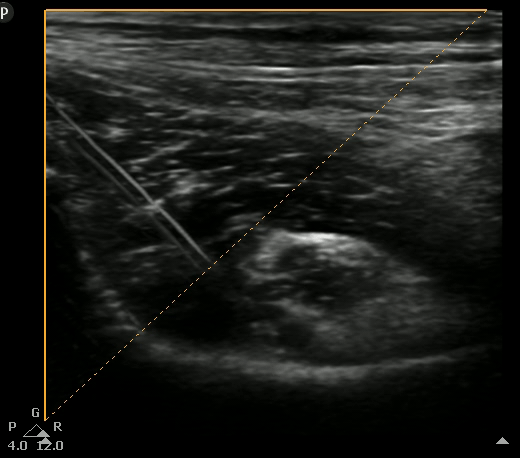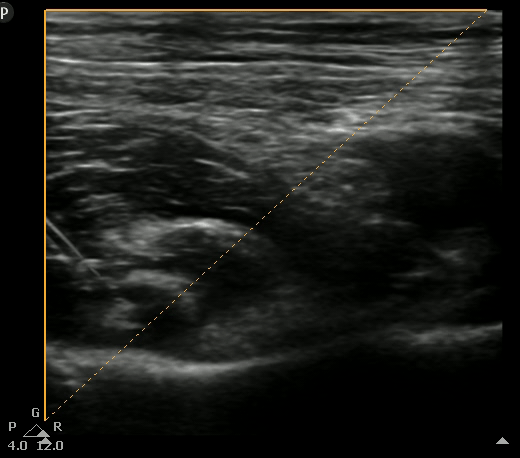Case 26 - That Block is PENG!
Author: Nick Mani Reviewer(s): Nish Cherian
A 50-year old lady presents to the Emergency Department after a fall, sustaining right acetabulum fracture. She has been given IV paracetamol and morphine but continues to be in discomfort, but keen to mobilise. The physios are requesting more analgesia before starting rehab in ED.
You elect to perform an ultrasound-guided nerve group block as part of a multi-modal pain management strategy as demonstrated below:




Clip Collection- (Press right/Left to change the clips)
Right Inguinal Region (Left- Lateral, Right- Medial)
Sono-Anatomy of the Performed Block
-
Pericapsular nerve group (PENG) block
-
Mainly for acetabulum or pubic rami fractures to spare the motor function of the nerves. However it could be utilised for post neck of femur fracture operation to allow for appropriate and timely physio/rehab.
-
Performed within 6hrs of the same/similar block
Infection over/around the injection site
Open wound at the site of injection/Intravenous drug user with acive injection site
Vascular surgery such as a bypass
NB anticoagulation/potent antiplatellets are ONLY a relative contraindications (https://www.ra-uk.org/images/Documents/RAPAC_for_consultation.pdf)
-
Curvilinear (lower frequency), particularly for patients with larger body habitus, and/or wanting to visualise the femoral neuromuscular structure in one image. However due to the resolution decreases compared to the linear probe (high frequency)
-
A - Femoral Nerve
B - Femoral Artery
C - Hydrodissection of local anaesthetic lifting up the hyperechoic psoas muscle tendon
-
Indigo line - Fascia lata (superficial one) and Iliaca (deep one)
Orange - Sartorius Muscle
Purple - Iliopsoas muscle
Yellow - Psoas Muscle Tendon
Green line - Pelvic bone margin (the peak laterally is anterior inferior iliac spine (AIIS), with the medial deep and eminence margins as iliopectineal eminence (IPE)
-
The lateral femoral cutaneous nerve is NOT blocked
ONLY Sensory branches of the femoral and obturator nerves are blocked (motor parts are spared)
-
Needle visualisation setting to steer the beam, therefore visualise the needle body/tip much better
SONO-ANATOMY & TECHNIQUE
The Pericapsular nerve group (PENG) block - Scanning Approach
Identify the anterior superior iliac spine (ASIS), place the probe over it and just under and parallel to the inguinal ligament slide and slightly rotate the probe in the lateral half.
Identify the anterior inferior iliac spine (AIIS), sartorius muscle in-between the fascia lata and iliaca, large belly of the iliopsoas muscle, and deeper hyperechoic poses tendon. Identify the neuromuscular bundle medially, the femoral artery will be obvious as the most round and pulsating vessel and medial to this lies the femoral vein (remember NAVY). However, the femoral nerve is not often easily visualised.
Slide back laterally to focus on the psoas tendon. Ensure the needle visualisation feature is turned on, and then insert the needle in-plane with the probe, Inject the local anaesthetic just under the psoas tendon and observe the lifting up of the tendon. If there is a high resistance, ever so slightly withdraw the needle as most likely it is right against the pubic bone.
Note that this is NOT a femoral nerve block or compartment block. The administer the anaesthetic under the psoas muscle, spreads along the plane containing the pericapsular nerve groups that are are ONLY the sensory branches of the femoral and obturator nerves (hip articular branches) as well as accessory obturator nerve. This requires adequate local anaesthetic (0.25% levobupivacaine or bupivacaine) VOLUME for coverage (20-30 ml total volume in most patients depending on patient weight). This is less than that required for fascia iliaca compartment block as the space is tight and the nerve branches are close to each other.
Image 1- Surface Anatomy of Different Hip/Pelvis Blocks
FICB (II)- Fascia Iliaca Compartent Blcok Infra-Inguinal, FICB (SI)- Fascia iliaca Compartment Block Supra-Inguinal, FN- Femoral Nerve Block, PENG- Peri-Capsular Nerve Group Block
Image 2- The Nerve Branches Blocked by PENG (Anterior Pelvic Skeletal View)
ASIS- Anterior Superior Iliac Spine, AIIS- Anterior Inferior Iliac Spine, FN- Femoral Nerve, aFN- articular Femoral Nerve (Supra-inguinal Branch), AON- Accessory Obturator Nerve, ON- Obturator Nerve, aON-articular branch of Obturator Nerve
Image 3- Ergonomicology/Safety
Patient, Performer, Assistant, Equipment, Monitoring, Check-list/Stop Before You Block
Note- the ultrasound machine is at the opposite side of the bed for this block
Clip 4a & 4b- Sono-Anatomy of the Performed Block In-Plane (Press right/Left to change the image)
A- Femoral Nerve, B- Femoral Artery, C- Hydrodissection of local anaesthetic lifting up the hyperechoic psoas muscle tendon
Indigo line- Fascia lata (superficial one) ,and Iliaca (deep one), Orange- Sartorius Muscle, Purple- Iliopsoas muscle, Yellow- Psoas Muscle Tendon , Green line- Pelvic bone margin (the peak laterally is anterior inferior iliac spine (AIIS), with the medial deep and eminence margins as iliopectineal eminence (IPE)
Image 5 - Cartoon demonstration of the PENG block (cross section anatomy, In-Plane technique)
SM- Sartorius Muscle, IPM- Iliopsoas Muscle, PM- Pectinous Muscle
FL- Fascia Lata, FI- Fascia Iliaca, AIIS- Anterior Inferior Iliac Spine, IPE- Iliopectineal Eminence
PT- Psoas Tendon, FN- Femoral Nerve, FA- Femoral Artery, FV- Femoral Vein, PENG- Pericapsular Nerve Group aFN- articular Femoral Nerve, AON- Accessory Obturator Nerve, ON- Obturator Nerve, aON-articular branch of Obturator Nerve
Case resolution
The patient had effective analgesia with the US-guided PENG block, was able to mobilise with the physios and discharged home with appropriate analgesia, walking aid, and follow-up.
Take home message
US-guided PENG block is a novel approach that spares the motor function of the femoral and obturator nerves. It is indicated for acetabulum and pubic rami fracture as well as post neck of femur fracture to allow timely and appropriate rehab/physio.






